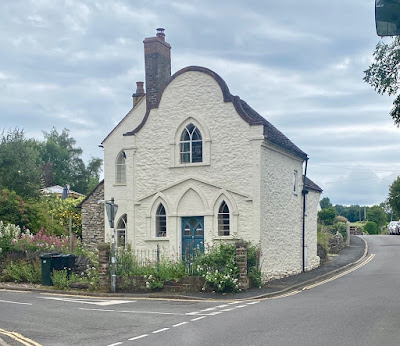I caught sight of this house on a late-afternoon walk in Much Wenlock. I’d already noticed one or two other examples in the town of this kind of architecture – early-19th century Gothick, in which pointed windows with Y-tracery set off the facades of quite modest buildings, often in combination with other features – pilasters, pediments, curved gables – that aren’t associated with the medieval Gothic style at all. This house is a good example of the decorative mélange that can result: pointed windows in pointed recesses, pilasters running up each side of the frontage,. a sloping cornice rather like a broken pediment above the central door and its accompanying windows, and, topping it all, a striking rounded gable that steps halfway down to turn from a convex to a concave curve. All this fronts what is otherwise quite a modest structure of rubble masonry and brickwork, all painted white.
The effect of the facade belies common misconceptions: that Georgian Gothick is filigree and delicate and that ornate gables like this are confined to eastern England, where the Dutch influence on English architecture was strong. So this building has left behind the delicate filigree Gothic of Walpole’s house, Strawberry Hill, rebuilt back in the 1740s, for something that’s frankly chunky and more suited to the abilities of a provincial builder; no doubt it was also to the taste of the owners of small houses in late-Georgian Shropshire. As for ‘Dutch’ gables, they were popular in coastal Lincolnshire and East Anglia a century and more before this house was built, and were by now another idea that had become assimilated. Pointed windows and curvaceous gables were, it seems, a matter of local fashion and choice. I’m glad those choices were made here.




2 comments:
If it were for sale - and I had some money - I would buy it. A bonus to be situated in Much Wenlock and in the middle of much of the Shropshire countryside, though finding the right bus stop and the right bus timetable might have made my own visit somewhat shorter! This is an example again of imagination and creativity being just as important as building a house.
As the bus waits at the traffic light next to the cliff of yet another hideous construction in central Cardiff - a plain, plain wall in some dark material stretching up many storeys with no mouldings or adornments or interesting-shaped openings whatsoever, I have time to reflect that 18th century builders in a remote rural place like Much Wenlock seem to have had a better deal all round. And that the posh architects of today could learn an amusing and evocative thing or two from the jobbing local builders of the past.
It's for sale now.
Post a Comment